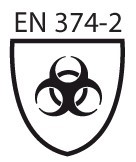| Types of Hazards:
During many tasks the hands are at significant risk of injury, therefore, the operative may be required to wear gloves as a last line of defence, after all other hazard controls have been put in place. It is generally accepted that the majority of hand injuries come from cuts and abrasions, with most of the more serious injuries being due to cuts. However, it is important that we consider the task we are completing and select the correct glove to protect us against that task’s specific hazards. To help us with this we use EN standards; which are usually printed on the back of gloves, and can also be found on packaging and product descriptions on websites. EN standards are designed to evaluate the performance of gloves material with regards to specific tests. Gloves are printed with a symbol which is then followed by a combination of numbers representing specifics regarding the level of protection they offer. WA Management also use EN standards on our risk assessments to indicate the necessary PPE for a task. Abrasion Resistance: Under a determined pressure the material is subject to abrasion by sandpaper. High abrasion ratings are important for work in areas such as construction and gardening. Cut Resistance (Coup Test): Based on the number of cycles required to cut the material at a constant speed. If you handle sheet metal, glass or sharp tools you should look for a glove with a high cut resistance rating. If, during this test, the blade used to cut becomes blunt, the straight blade cut resistance ISO 13997 testing method is used. Tearing Strength: Calculated from the force required to tear the material apart. A high tear rating is related to durability, making gloves ability to withstand demanding work such as construction, landscaping and heavy handling. Puncture Resistance: Is determined by the force required to puncture the material with a tip. Being puncture resistant gives gloves greater protection against sharp objects such as needles, thorns and syringes making gloves with a high puncture rating ideal for medical or waste work. Straight Blade Cut Resistance ISO 13997: This cut resistance test is based on the amount of force required to achieve a cut using a straight blade and is given as a rating from A-F; with A being the lowest and F the highest. Impact Resistance: This is an optional test based on mean transmitted force. This test is a pass or fail; therefore, if a glove meets this requirement a P is added as the last digit to the glove marking. Chemical Hazards (EN 374)
(All information correct as of 1st December 2018)
Need more information? Our team of expert consultants can advise on PPE and more – get in touch! |





